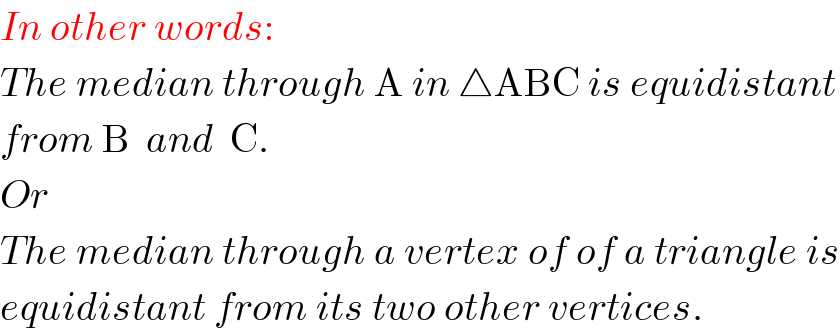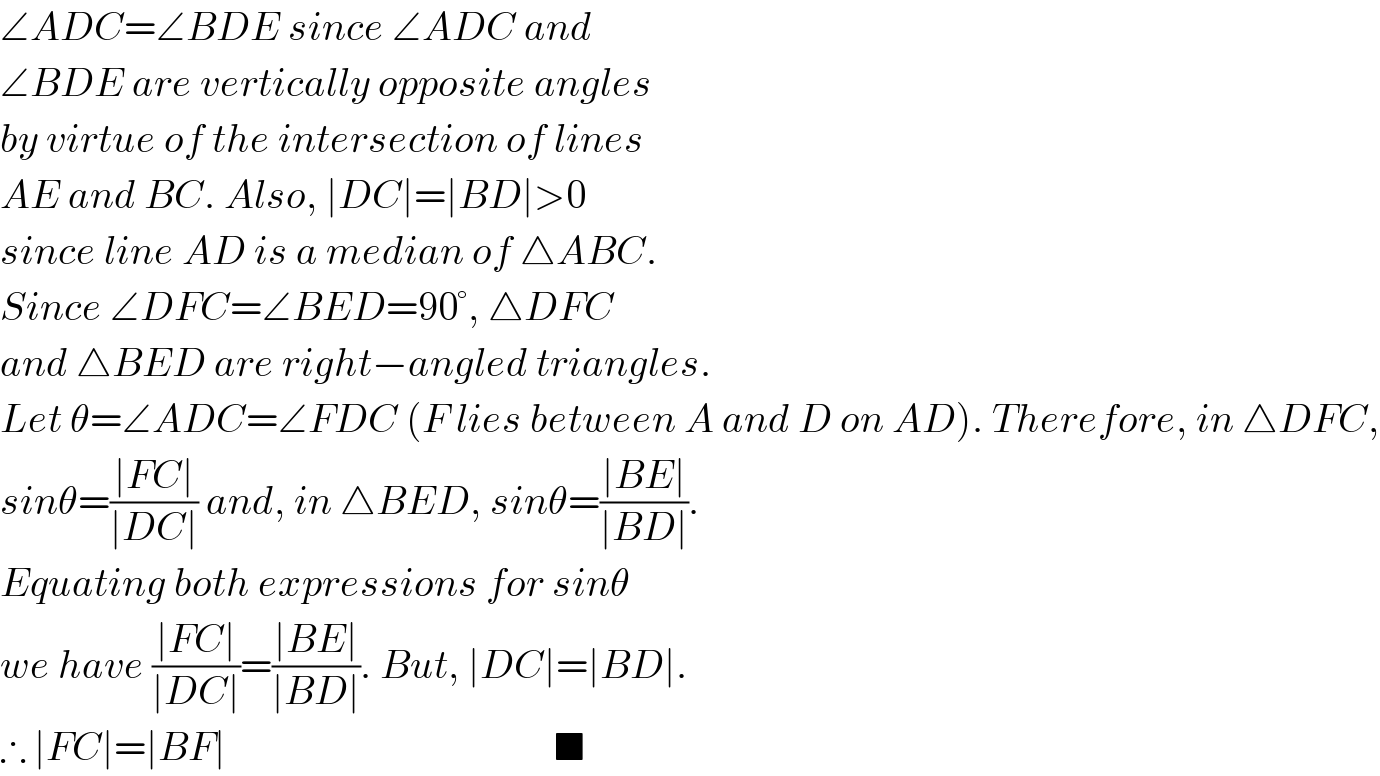
Question Number 6635 by Rasheed Soomro last updated on 07/Jul/16

Commented by Rasheed Soomro last updated on 09/Jul/16

$${In}\:{other}\:{words}: \\ $$$${The}\:{median}\:{through}\:\mathrm{A}\:{in}\:\bigtriangleup\mathrm{ABC}\:{is}\:{equidistant} \\ $$$${from}\:\mathrm{B}\:\:{and}\:\:\mathrm{C}. \\ $$$${Or} \\ $$$${The}\:{median}\:{through}\:{a}\:{vertex}\:{of}\:{of}\:{a}\:{triangle}\:{is} \\ $$$${equidistant}\:{from}\:{its}\:{two}\:{other}\:{vertices}. \\ $$
Commented by Rasheed Soomro last updated on 07/Jul/16

$${In}\:{triangle}\:\mathrm{ABC}\:,\:\mathrm{D}\:{is}\:{the}\:{midpoint}\:{of}\:\mathrm{BC} \\ $$$$\overset{\leftrightarrow} {\mathrm{AD}}\:\:{is}\:{a}\:\:{median}-{line}.\:\mathrm{BE}\bot\overset{\leftrightarrow} {\mathrm{AD}}\:{and}\:\:\mathrm{CF}\bot\overset{\leftrightarrow} {\mathrm{AD}} \\ $$$${Prove}\:{that}\:\mid\mathrm{BE}\mid=\mid\mathrm{CF}\mid. \\ $$
Answered by Yozzii last updated on 07/Jul/16

$$\angle{ADC}=\angle{BDE}\:{since}\:\angle{ADC}\:{and} \\ $$$$\angle{BDE}\:{are}\:{vertically}\:{opposite}\:{angles} \\ $$$${by}\:{virtue}\:{of}\:{the}\:{intersection}\:{of}\:{lines} \\ $$$${AE}\:{and}\:{BC}.\:{Also},\:\mid{DC}\mid=\mid{BD}\mid>\mathrm{0} \\ $$$${since}\:{line}\:{AD}\:{is}\:{a}\:{median}\:{of}\:\bigtriangleup{ABC}. \\ $$$${Since}\:\angle{DFC}=\angle{BED}=\mathrm{90}°,\:\bigtriangleup{DFC}\: \\ $$$${and}\:\bigtriangleup{BED}\:{are}\:{right}−{angled}\:{triangles}. \\ $$$${Let}\:\theta=\angle{ADC}=\angle{FDC}\:\left({F}\:{lies}\:{between}\:{A}\:{and}\:{D}\:{on}\:{AD}\right).\:{Therefore},\:{in}\:\bigtriangleup{DFC}, \\ $$$${sin}\theta=\frac{\mid{FC}\mid}{\mid{DC}\mid}\:{and},\:{in}\:\bigtriangleup{BED},\:{sin}\theta=\frac{\mid{BE}\mid}{\mid{BD}\mid}. \\ $$$${Equating}\:{both}\:{expressions}\:{for}\:{sin}\theta\: \\ $$$${we}\:{have}\:\frac{\mid{FC}\mid}{\mid{DC}\mid}=\frac{\mid{BE}\mid}{\mid{BD}\mid}.\:{But},\:\mid{DC}\mid=\mid{BD}\mid. \\ $$$$\therefore\:\mid{FC}\mid=\mid{BF}\mid\:\:\:\:\:\:\:\:\:\:\:\:\:\:\:\:\:\:\:\:\:\:\:\:\:\:\:\:\:\:\:\:\:\:\:\:\:\:\:\:\:\blacksquare \\ $$
Commented by Rasheed Soomro last updated on 07/Jul/16

$${The}\:{triangles}\:{can}\:\:{also}\:\mathrm{be}\:\:{proved}\:\mathrm{congruent}\:\:{using} \\ $$$$\mathrm{A}.\mathrm{S}.\mathrm{A}\approxeq\:\mathrm{A}.\mathrm{S}.\mathrm{A}\:\mathrm{theorm}. \\ $$
